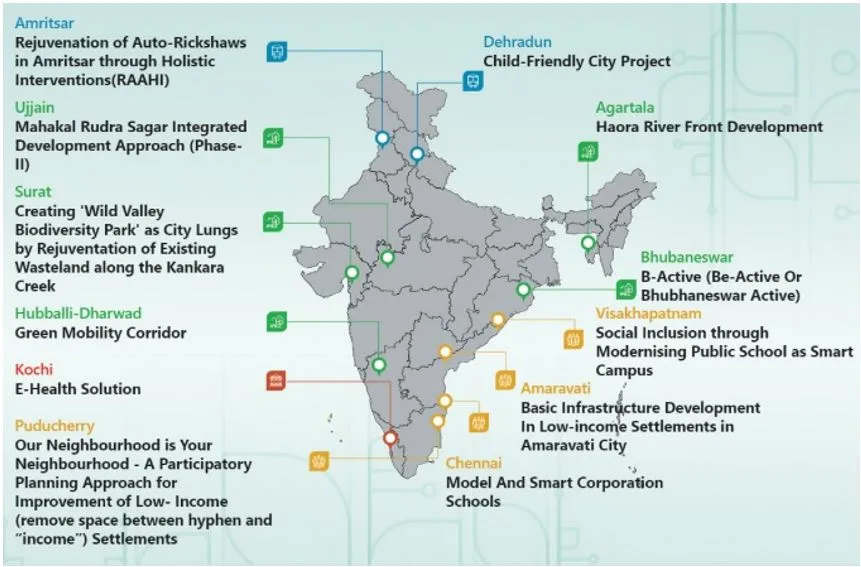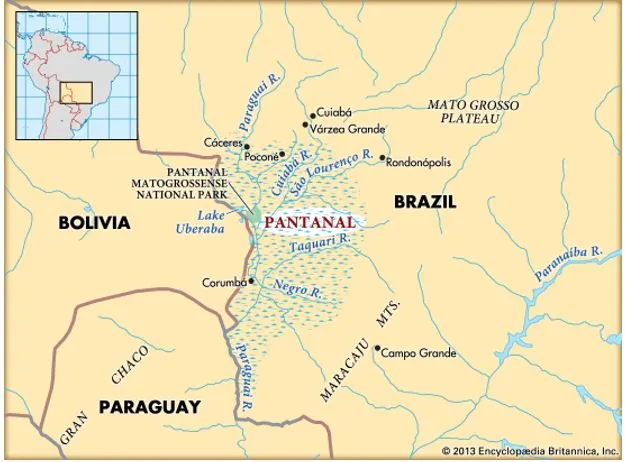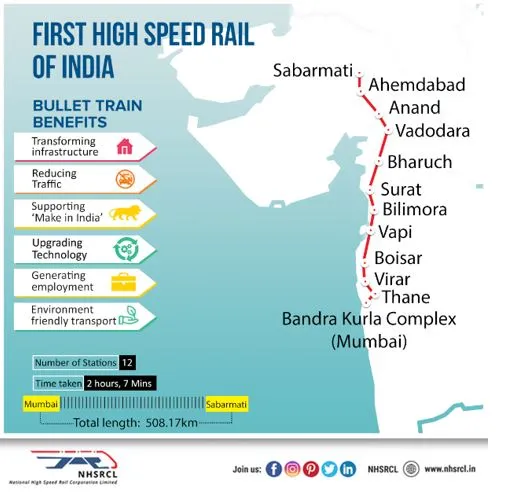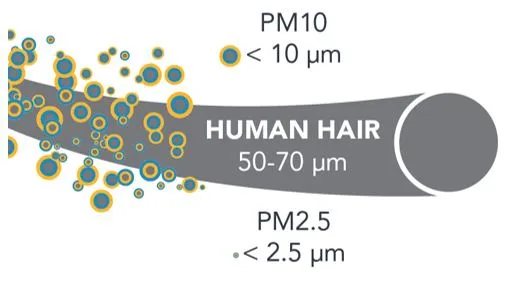

4th July 2024 (10 Topics)
Mains Issues
Context
The government notified the governing board and the executive council of the Anusandhan National Research Foundation (ANRF). However, the executive and governing boards of ANRF has no representation from Indian industry. There is also no presence of State universities, who the ANRF had said would be among the major beneficiaries of the new structure.
About ANRF
- Anusandhan National Research Foundation (ANRF) is a new research funding agency with an outlay of Rs 50,000 crore over the next five years.
- ANRF aims to consolidate research funding previously managed by the Science and Engineering Research Board (SERB).
- It will foster research and innovation across India's universities, colleges, and laboratories in natural sciences, engineering, health, agriculture, and more and enhance the country's Research and Development (R&D) capabilities.
- Structure and Leadership:
- Governing Board (15 members): Headed by Prime Minister Narendra Modi as President, with Ministers of Science & Technology and Education as Vice Presidents. Includes Secretaries from key departments and advisors.
- Executive Council: Chaired by the Principal Scientific Adviser, consisting of Secretaries from various ministries and CEOs.
- The bill (Anusandhan National Research Foundation Bill, 2023) to establish the ANRF was passed by both the Houses of Parliament in August last year.
- The ANRF is a move to provide a high-level strategic direction for research, innovation and entrepreneurship in the fields of natural sciences, including mathematical sciences, engineering and technology, environmental and earth sciences, health and agriculture, and have long-term effect and outcomes for each citizen.
Comparison with SERB Act, 2008:
|
|
SERB Act, 2008 |
Anusandhan National Research Foundation (ANRF) Act |
|
Funds |
SERB funded solely by the government.
|
ANRF seeks contributions from both government and private sources |
|
Governance |
Chaired by the Secretary of the Department of Science and Technology |
Led directly by high-level officials |
|
Scope |
Promoting basic research in Science and Engineering |
ANRF expands beyond natural sciences to include mathematics, humanities, social sciences, and art, aiming to address national priorities like clean energy and sustainable infrastructure |
|
Participation |
Hard for private research organisations to contribute to NRF funding body. |
Aims to involve Government institutions, colleges, Universities, higher educational institutions and private sector organisations |


Mains Issues
Context
Recent research by the National Council of Applied Economic Research (NCAER) has highlighted a significant decline in poverty in India, despite challenges posed by the pandemic. According to the study titled 'Rethinking Social Safety Nets in a Changing Society', poverty has decreased from 21.2% in 2011-12 to 8.5% in 2022-24.
What is Poverty?
- Poverty goes beyond income scarcity, encompassing challenges like poor health, inadequate education, unsafe living conditions, and vulnerability to violence.
- The NITI Aayog currently measures poverty through Multidimensional Poverty Index (MPI). The MPI captures overlapping deprivations (dimensions of poverty) in health, education and living standards.
- Multidimensional Poverty: Measures multiple deprivations in daily life such as poor health, lack of education, inadequate living standards, disempowerment, poor quality of work, the threat of violence, and living in areas that are environmentally hazardous, among others.
- Multidimensionally poor:An individual who is deprived of one-third or more of the weighted indicators.
- Extreme Multidimensional Poverty: Any person deprived of one-half or more of the weighted indicators.
Key-findings of the Report
- Poverty declined significantly between 2004-2005 and 2011-12 (from a headcount ratio of 38.6 to 21.2), and it continued to decline between 2011-12 and 2022-24 (from 21.2 to 8.5) despite the challenges posed by the pandemic.
- Responsible factors for decline in poverty: Economic growth played a crucial role in this positive trend. Even amidst pandemic difficulties, poverty continued to decrease, underscoring the resilience of India's economic fabric.
Challenges: As India progresses towards equitable development, adapting social protection programs becomes crucial.
- Required measures: The research emphasizes that traditional strategies for chronic poverty may need revision, as economic growth shifts the focus towards addressing transient factors like natural disasters, health crises, and changes in employment opportunities.
How poverty impacts India’s economy? |
Benefits of reducing Poverty |
|
|
Fact Box:Poverty Line
Government Measures to eliminate poverty:
|
PYQQ1: ‘Despite the implementation of various programmes for the eradication of poverty by the government in India, poverty is still existing’. Explain by giving reasons. (2018) Q2: “An essential condition to eradicate poverty is to liberate the poor from the process of deprivation.” Substantiate this statement with suitable examples. (2016) |


Mains Issues
Context
The Ministry of Housing and Urban Affairs has extended the deadline for the Smart Cities Mission till March 2025, allowing cities to complete ongoing projects, which account for around 10% of the total projects.
What is the concept of Smart Cities?
- The concept of smart cities emerged after the 2009 financial crash. It aimed to integrate urban centres with advanced communication networks and infrastructure.
- In India, the Smart Cities Mission (SCM) was initiated in 2015, aiming to develop 100 cities.
- Need of smart cities in India (unprecedented urban expansion):
- By 2030 India will be home to 60 cities with a population of more than 1 million and 6 megacities with a population of more than 10 million.
- Significant challenges hindering urban development and economic growth:
- Poor local governance
- Inadequate infrastructure and services
- Outdated urban planning
- Megacities (Delhi, Mumbai) are regarded as the economic engines of India, and yet every year, heavy rainfall lasting a couple of hours or days causes havoc there.
- Slums
Smart Cities’ Report Card (Progress so far)
- As of July 3, 2024, the 100 cities involved in the Smart Cities Mission have successfully completed 7,188 projects, which accounts for 90% of the total projects planned. These projects amount to ?1,44,237 crore. Additionally, 830 more projects worth ?19,926 crore are nearing completion.
- Budget Allocation and Utilization:
- The Government of India (GOI) allocated ?48,000 crore for the Smart Cities Mission.
- As of now, GOI has released ?46,585 crore, which is 97% of the allocated budget.
- Cities have utilized 93% of the released funds for various development projects.
- Financial Support: GOI has provided full financial support to 74 out of the 100 cities participating in the Mission.
- Multi-Sectoral Projects: Across the 100 cities, more than 8,000 multi-sectoral projects are underway, with a combined worth of approximately ?1.6 lakh crore.

Challenges
- Urban Local Bodies (ULBs) lack core competence, trained manpower and finances for completion of urban infrastructure projects.
- Local challenges related to land, labor etc., has also led to slowdown in progress.
- Irregularities in implementation of works such as redoing of same work again & duplication of work, project cost higher than the market rate, frequent dropping of projects after finalization of proposals, etc.
- Special Purpose Vehicles (SPVs): SPVs face uncertainty as they won't receive further funding for operations, including Integrated Command and Control Centers (ICCCs).
- SPVs can't initiate new projects with Mission funding since the original Smart Cities Mission period ended in June 2021.
Solution:
- Information and communication technology, sensors, geospatial, IoT, AI and blockchain are crucial to tackle the emerging problems in the city and maintain law and order through detailed data analysis.
- Geospatial visualization, HD maps, and interactive 3D models and dashboards are also of great help.
PYQQ1: What are ‘Smart Cities’? Examine their relevance for urban development in India. Will it increase rural-urban differences? Give arguments for ’Smart Villages’ in the light of PURA and RURBAN Mission. (2016) Q2: Discussion the various social problems which originated out of the speedy process of urbanization in India. (2013) |


Prelims Articles
Context
June 30 marks the 169th anniversary of the Santhal Hul, one of the earliest uprisings against British colonial oppression in India.
About the Uprising
- The Santhal Hul (revolution) was a tribal revolt against the atrocities of the upper-caste landlords, moneylenders, traders, police, and administrative officials from the East India Company in the erstwhile Bengal presidency.
- Led by: Murmu brothers — Sidho, Kanho, Chand, and Bhairav — along with sisters Phulo and Jhano.
- The Santhals, originally settled in areas of present-day Jharkhand, faced severe exploitation following their displacement from various regions under British rule.
- Promised lands for settlement and agriculture, they instead experienced land-grabbing and bonded labor practices known as begari.
- The Uprising
- In response to these injustices, around 60,000 Santhals rallied against the East India Company in 1855.
- Their resistance was guided by their belief in Thakur Bonga, their spiritual deity.
- Engaging in guerrilla warfare, they fought for nearly six months before the British finally suppressed the revolt in January 1856.
- The brutal aftermath saw over 15,000 Santhals killed and thousands of villages destroyed.
- Legacy and Impact: Despite the suppression, the Santhal Hul left an enduring impact. The sacrifices of leaders like Sidho and Kanho Murmu catalyzed legislative changes aimed at protecting Adivasi rights.
- The Santhal Pargana Tenancy Act of 1876 (SPT Act) and the Chhotanagpur Tenancy Act of 1908 (CNT Act) were direct outcomes of these struggles.
- The Santhal Pargana Tenancy Act of 1876 (SPT Act): Prohibits the transfer of Adivasi lands (urban or rural land) to non-Adivasis, was the result of the Hul. The land can only be inherited as per the Act, thus retaining the rights of Santhals to self-govern their land.
- The Chhotanagpur Tenancy Act, (CNT Act) enacted by the British in 1908 a result of the Birsa Movement, allows land transfers within the same caste and certain geographical areas with the approval of the District Collector. This Act also restricts the sale of Adivasi and Dalit land, while allowing land transfers between Adivasi individuals from the same police station and Dalits in the same district.
Major Tribal Uprisings
|
Year |
Tribal Uprising |
Features |
|
1776 |
Chuar Uprising |
It was initiated by indigenous tribespeople of Midnapore, in response to land revenue demands and economic hardships. |
|
1818-1831 and 1913 |
Bhil Uprising |
The Uprising took place in the Western Ghats as a resistance against the rule of the Company. It resulted in the formation of Bhil Raj. In 1913, under the leadership of Govind Guru, the Bhil community reorganized and continued their fight for the establishment of Bhil Raj. |
|
1820–37 |
Ho and Munda Uprisings |
The Ho and Munda Uprisings were initiated by the Ho tribals under the leadership of Raja Parahat in the Singhbhum and Chottanagpur regions. These uprisings were in response to the implementation of a new farming revenue policy. Over time, the Ho uprising transformed into the Munda rebellion. |
|
1822-29 |
Ramosi Uprising |
It was led by the Ramosi tribals residing in the Western Ghats. Under the leadership of Chittur Singh, they revolted against the British occupation of the region. |
|
1829 |
Koli Uprising |
The Uprising witnessed multiple revolts by the tribal communities of Gujarat and Maharashtra. They rebelled against the control of the East India Company in the years 1829, 1839, and once more during the period of 1844-48. |
|
1832 |
Kol Rebellion |
It occurred when the tribal communities of Chottanagpur, led by Buddho Bagat, revolted against the British colonial rule and oppressive money lenders. |
|
1837-56 |
Khond Rebellion |
The Rebellion saw the tribal communities residing in the hills from Tamil Nadu to Bengal, led by Chakra Bisoi, rise up against the interference in their tribal customs and the imposition of new taxes. |
|
1899-1900 |
Munda Rebellion |
It involved the tribal population of the Chotanagpur area who, under the leadership of Birsa Munda, revolted against the 'Dikus' (a term used to refer to outsiders or non-tribal people). |
|
1879-80 |
Koya Uprising |
The Uprising witnessed the tribal communities of the eastern Godavari region, led by Tomma Sora and Raja Annantyar, rebelling against the oppressive actions of the police and moneylenders. |
|
1910 |
Bastar Revolt |
The Revolt was staged by the tribal population of Jagdalpur as a protest against the imposition of new feudal and forest levies. |
|
1921-22 |
Chenchus Uprising |
The Uprising took place when the tribal community of Nallamalla Hills, led by K. Hanumanthu, revolted against the forest laws imposed by the British authorities. |
|
1922-24 |
Rampa Rebellion |
It was led by Alluri Sitaraman Raju, a member of the Koya tribe in Andhra Pradesh. The rebellion was launched in response to British interference in the region. |


Prelims Articles
Context
This year, the Pantanal, the world’s largest tropical wetland, has experienced unprecedented fires due to severe water loss. A recent study highlighted that the area covered by water in 2023 was 61% below average, significantly affecting the ecosystem.
Key Points:
- Pantanal's Water Loss: In 2023, only 2.6% of the Pantanal was covered by water, a drastic reduction compared to previous years. This has led to extreme dry conditions, making the region prone to wildfires.
- Impact on Biodiversity: The Pantanal is renowned for its biodiversity, hosting species like jaguars and capybaras. The drying has endangered these species and their habitats.
- Amazon and Other Biomes: The Amazon also faced challenges with a reduced water surface, impacting fish and dolphin populations due to severe droughts. The Pampa grasslands and the Cerrado showed mixed results in water surface changes.

About Pantanal (Brazil, South America)
- The Pantanal is the world’s largest freshwater wetland, a seasonally flooded plain fed by the tributaries of the Paraguay River. At 68,000 square miles, it is more than 20 times the size of the Everglades.
- Location:Located in the upper Paraguay River basin, the Pantanal straddles Brazil’s border with Bolivia and Paraguay. About 80 percent of the Pantanal is in Brazil. It sprawls across three countries—Bolivia, Brazil, and Paraguay.
- Major Habitat Type: Flooded Grassland Savanna
- The Pantanal is also one of the world’s most productive habitats.
- Flora and Fauna: Iconic species found in the Pantanal include the jaguar (the highest density in the world), giant otters, capybaras (the largest rodent species), anteaters, tapirs, caimans, and a diverse array of birds such as toucans and jabiru storks.


Prelims Articles
Context
The Mumbai-Ahmedabad bullet train is expected to begin operations in Gujarat by 2027 end and will later be extended to Maharashtra, according to the National High Speed Rail Corporation Limited (NHSRCL).
About Mumbai-Ahmedabad Bullet Train Project:
- The foundation stone for the Mumbai-Ahmedabad bullet train project was laid in 2017.
- Speed and Distance: The bullet train will zip along at 320 kmph, covering the 508.17 km distance between Mumbai and Ahmedabad in just about two hours.
- Cost and Completion: Estimated at Rs 1.65 lakh crore, the project is slated for completion by 2028.
- National High-Speed Rail Corporation Limited: Established under the Companies Act, 2013, NHSRCL aims to finance, construct, maintain, and manage high-speed rail corridors across India.
- The Need for High-Speed Rail
- Challenges of Indian Railways: With over 67,415 route km, Indian Railways forms the backbone of the nation's transport system. However, overcrowding on main routes, with some operating at 150% capacity, has slowed down travel speeds and shifted traffic to less efficient road transport.
- Logistical Constraints: Congestion on rail routes increases turnaround times for goods, impacting manufacturing efficiency and competitiveness.
- Benefits of High-Speed Rail
- Capacity Release and Safety: High-speed rail will alleviate congestion on existing lines, enhancing passenger safety and comfort.
- Environmental Impact: Powered by indigenous electric power, high-speed rail reduces dependence on imported fuels, lowering greenhouse gas emissions.
- Airport Congestion: By reducing short-haul flights, high-speed rail frees up airport capacity for more economical long-haul flights.
- Global Examples: Successful implementations in Japan, Europe, and China demonstrate how high-speed rail enhances connectivity and boosts economic growth.
- A study found that towns connected by high-speed rail saw their GDP riseby at least 2.7 per cent compared to those not on the route.



Prelims Articles
Context
The Lancet study reveals a serious link between air pollution and deaths in Indian cities like Delhi. Pollution particles like sulfur dioxide and nitrogen dioxide can cause respiratory issues like coughing and chest tightness.
Key-highlights of the Study
- Between 2008 and 2019, 7.2% of all deaths (approximately 33,000 each year) in 10 cities in India every year can be attributed to air pollution levels that are below India's national clean air threshold.
- Delhi recorded the highest number of air pollution-related deaths in the study period - a staggering 11.5% i.e. 12,000 deaths each year.
- India's clean air norms are presently well above the World Health Organisation guideline of 15 micrograms in every cubic meter of air.
Fact Box: What is PM 2.5?
|


Editorials
Context
The discussion on whether India needs a new poverty line centers on the criteria used to measure poverty and its implications for welfare benefits. This issue addresses the adequacy of current poverty thresholds, regional economic disparities, and the capacity of statistical machinery to capture accurate data.
Poverty Thresholds in India:
- Introduction to the Issue: The poverty line in India has evolved over time, with various committees proposing different definitions based on calorie intake and non-food expenditures. The Tendulkar Committee's thresholds from 2009 and 2011 remain the official benchmarks.
- Calorie-Based Definition: Initially, poverty was measured by calorie intake, determining the income needed to consume around 2,000 calories per day. This simplistic approach was later expanded to include essential non-food expenditures.
- Committee Recommendations: The Tendulkar Committee set the poverty line at Rs 447 per month in rural areas and Rs 579 in urban areas in 2009, revised to Rs 816 and Rs 1,000 respectively in 2011. Despite subsequent recommendations from other committees, these thresholds persist.
Measuring Poverty for Welfare Transfers:
- Urban vs. Rural Perspectives: It's crucial to avoid judging poverty thresholds through an urban lens, as purchasing power varies significantly across regions. A single definition may not encompass India's economic heterogeneity.
- Relative Poverty: Poverty can be viewed as relative to societal standards. A poverty threshold could be defined as an income below a certain percentage of the median income, varying by region.
- Statistical Machinery: Accurate poverty measurement requires robust statistical tools to capture household expenditures and incomes. The absence of a recent Census hampers this effort, making it difficult to implement effective poverty measurement on the ground.
Expansive Definition of Poverty:
- Amartya Sen’s Perspective: Economist Amartya Sen's view of development emphasizes expanding people's freedoms. Poverty should be seen as a lack of agency to aspire for a better life.
- Escaping State Dependence: In India, escaping poverty often means minimizing dependence on the state by accessing private services. This includes private security, healthcare, education, and other amenities.
- Measurement of Agency: Household surveys should include questions about interactions with the bureaucracy and government services. The fewer interactions needed, the greater the indicator of prosperity and reduced poverty.
UPSC Mains Questions:
Q. Discuss the evolution of poverty thresholds in India. How do different definitions of poverty impact welfare policies and their implementation?


Editorials
Context
Recent controversies in Indian medical research, particularly the Covaxin trial in Bhopal, have highlighted ethical challenges in clinical trials and drug development. These events underscore issues of informed consent, regulatory oversight, and protection of vulnerable populations, emphasizing the need for stronger ethical frameworks and accountability in India's healthcare and pharmaceutical sectors.
Ethical Violations in Clinical Trials
- Introduction to the Issue: The controversy centers around alleged ethical violations during the clinical trials of Bharat Biotech’s Covaxin at the People’s Hospital in Bhopal. Allegations include the lack of informed consent, enrollment of vulnerable populations, and inadequate reporting of adverse events.
- Regulatory Oversight and Ethical Lapses: The approval process by the Central Drugs Standard Control Organisation (CDSCO) is scrutinized, especially the introduction of terms like “Restricted Use under Clinical Trial Mode,” which lack a clear legal framework.
- Role of Ethics Committees: The functioning of ethics committees at trial sites is questioned, with concerns about their effectiveness and transparency. The Supreme Court's intervention underscores the need for public disclosure of clinical trial data.
Challenges Faced by Whistleblowers
- Whistleblower Risks: The editorial highlights the experiences of whistleblowers who expose ethical violations in medical trials, drawing parallels with global cases documented by bioethicist Carl Elliott.
- Inadequate Legal Protection: India's weak whistleblower protection laws, further diluted in 2015, fail to safeguard those exposing wrongdoing. The societal and institutional pressures against whistleblowers are emphasized.
- Cultural and Social Barriers: Deep-rooted issues like groupthink, fear of retribution, and social conformity hinder the emergence of whistleblowers. The need for a cultural shift towards valuing integrity and dissent is highlighted.
Systemic Issues in Medical Research
- Lack of Expertise in Drug Development: The editorial points out that India’s medical community lacks the necessary expertise in clinical development, often leading to ethical compromises in trials.
- Informed Consent and Vulnerable Populations: There is a historical pattern of enrolling poor and uneducated individuals in trials without proper informed consent. This is exacerbated by the inadequate functioning of institutional ethics committees.
- Regulatory Failures: A 2022 study in PLOS Global Public Health identified numerous problems with the ethics committees' operations in India, including the approval of clinical trials without proper oversight.
UPSC Mains Questions:
Q. Discuss the ethical challenges in conducting clinical trials in India. How can the regulatory framework be strengthened to address these challenges?


Editorials
Context
The recent factory explosion in the Dombivli Maharashtra Industrial Development Corporation (MIDC) area highlights systemic issues in industrial safety and the effectiveness of the labour inspection system in India. This incident, along with previous accidents, underscores the need for comprehensive reform in the inspection and regulatory mechanisms to ensure worker safety and compliance with industrial regulations.
Issues with Industrial Safety and Inspections
- Frequency of Accidents: Industrial accidents in Maharashtra have been frequent, with significant incidents reported in 2016, 2018, 2020, and 2023. The recent explosion in 2024 further exemplifies ongoing safety issues.
- Inspection Rates and Personnel Shortages: In Maharashtra, only 23.89% of hazardous factories and 8.04% of registered factories were inspected in 2021. Personnel shortages contribute to this low inspection rate, with only 39.34% of sanctioned officers appointed.
- Prosecution Rates: The low prosecution rates in states like Gujarat (6.95%), Maharashtra (13.84%), and Tamil Nadu (14.45%) diminish the deterrent effect of inspections, leading to persistent safety violations.
Challenges and Criticisms of the Inspection System
- Inspector-Raj and Corruption: Employers often criticize the inspection system as "inspector-raj," citing harassment and bribery. While there are instances of misuse of power by inspectors, employers are also complicit in avoiding compliance through corrupt practices.
- Self-Certification and Randomized Inspections: Reforms like self-certification, randomised inspections, and third-party certification have been introduced but fail to address the core issues. These measures violate the International Labour Organization’s Labour Inspection Convention (081), 1947, which mandates qualified inspectors and unannounced inspections.
- Ineffective Reforms: The current reforms have not strengthened labour market governance. Instead, they have weakened the inspection system, failing to ensure compliance with safety regulations and exposing workers to greater risks.
Recommendations for Effective Inspection Reforms
- Strengthening Labour Market Governance: Governments should implement the provisions of the ILO Convention, ensuring sufficient qualified inspectors and unannounced inspections to secure compliance with labour laws.
- Penalties for Government Failures: There should be a penal system for government officials who fail in their duty to enforce safety regulations, ensuring accountability and compliance.
- Balancing Inspection and Facilitation: Inspectors should not only enforce laws but also provide advice to employers and unions, helping them comply with regulations and improving overall industrial safety.
UPSC Mains Questions
Q. Discuss the systemic issues in India's labour inspection system highlighted by recent industrial accidents. Suggest measures to reform the inspection system to ensure worker safety and compliance with industrial regulations.




